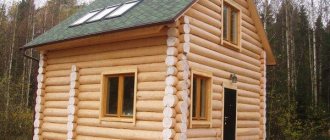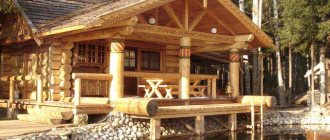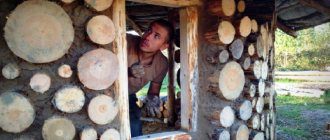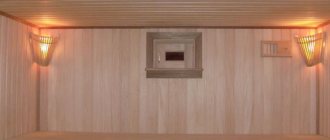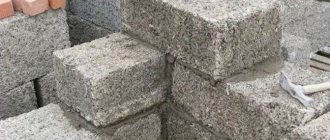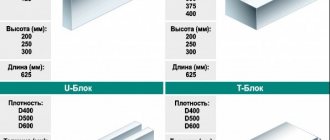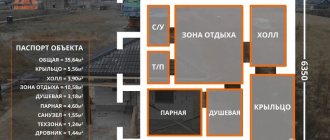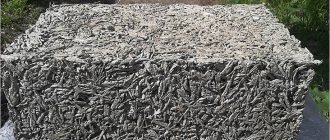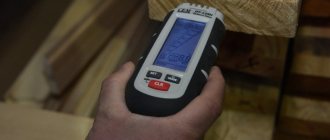In connection with the next rise in prices for wood and other building materials, even people without any special financial problems began to look for where to grab something cheaper, without sacrificing quality. An acquaintance of mine, who dreams of installing a Russian bathhouse on his property, found an aspen frame at the “old” price. But, having heard a lot of negative reviews about this wood, he turned to me for advice. I had to go and look in person, because an aspen bathhouse can last a hundred years, or it can rot in just five years - it all depends on the condition of the logs, the quality of the cutting, and the processing of the material. Surely many people will need information about the characteristics of aspen, so I’m telling you.
Source ekenex.com
How to choose round timber for a log house
If there is such a possibility, then aspen for the bathhouse should be selected at the stage of harvesting the round timber. What is important here is the time of felling, the place where the tree grows, and its age.
Aspen prefers damp places and likes to grow in swamps, so its wood is very juicy and “wet.” Moreover, the moisture content of the wood increases from the base to the top. In such an environment, putrefactive processes quickly develop, and when drying, the tree, losing moisture, becomes severely deformed and cracks.
However, a bathhouse or house made of aspen turns out to be warm, cozy and durable if the following conditions are met when harvesting round timber:
- the tree should be no more than 50 years old, since with age it begins to rot right at the root;
- felling was carried out from March to May;
- healthy logs, untouched by rot, were selected for the manufacture of the log house;
- drying was carried out correctly.
Source kelohouse.ru
The longer the log, the more it twists when it shrinks. Therefore, for an aspen log house, they immediately cut off the tops 4-5 meters long and dry them in the bark, making longitudinal cuts on it and leaving a few upper branches. This takes about six months. The rest of the wood is used for firewood, making dishes, wooden barrels, and making matches.
Such a complex and long preparatory stage with a minimal yield of timber in our time of pursuit of profit is not to the liking of all harvesters, which is why it is difficult to find high-quality aspen. If you have to choose a round timber, then you need to carefully inspect literally every log, rejecting specimens with a loose core, deep cracks and severe deformation.
And not only examine, but also smell. This is not a joke - rotting processes cannot always be detected by visual inspection, but the sweet smell of vanilla will definitely give them away. Healthy wood smells like grass, slightly bitter.
Source dic.academic.ru
Characteristics
This tree species is a serious competitor to coniferous wood. At its low cost, the tree has a rather interesting texture and a completely unobtrusive smell, which is favorable for allergy sufferers.
The production of aspen lining consists of several stages:
- Determination of wood suitability.
- Drying.
- Grinding the front surfaces to achieve perfect evenness.
- Application of tongues, folding.
- Rejection of bad products.
- Product packaging.
In order to choose a quality product, you need to familiarize yourself with all the requirements and characteristics of the product. It would be more correct to choose one that fully complies with all the requirements of GOST 8242-88.
However, today it is difficult to do this, since most manufacturers have switched to working on individual technical conditions.
High-quality aspen lining should have a flat and smooth surface. It should be without a hint of any defects in the form of chips, cracks, holes and knots. Also, material of impeccable quality cannot show signs of mold and mildew.
How to choose a log house
When choosing a log house for a bathhouse made of aspen, the first thing we do is inspect, feel, pick, and smell. Everything is the same as with round timber. For now, we don’t pay attention to the unsightly, unsightly color - after sanding the logs don’t look very presentable, but after sanding they will become smooth and white. In general, aspen wood is the lightest and evenly colored.
Much more important is the method of cutting corners. It is better if they are made into a bowl - such a connection better holds the logs in a given position, preventing them from being severely deformed and twisted with the appearance of inter-crown cracks. However, if the round timber was properly dried before cutting, the type of corner joints is no longer of much importance.
Source na-dache.pro
One more point: aspen as a building material requires protection from constant exposure to moisture. In the bathhouse, the humidity is not constant; it alternates with complete drying, which is why aspen becomes even stronger and harder than oak. But the lower crowns, sucking moisture from the soil or foundation, can quickly rot. It is better to make them oak.
Features of pine lining
The wood of this tree has the following properties:
- Strength;
- Moisture resistance;
- Excellent sound insulation;
- High thermal insulation;
- Ability to withstand temperatures above 100 degrees;
- Long shelf life;
- Aesthetic appearance;
- Good antibacterial properties;
- Unobtrusive smell.
By choosing aspen lining as a finishing material, you don’t have to think about repairs for at least 10-15 years. Over the years, the material does not deform, and thanks to its interesting texture, it is suitable for creating a style of any direction.
Aspen lining is a universal material and can be used for both interior and exterior decoration. The material has a very affordable price, so it is very popular among consumers.
How to build and operate a bathhouse
I’ll tell you about the pros and cons of a bathhouse made of aspen beams or logs, this will help you understand how to prevent it from rotting and make the most of all the advantages of wood.
A dry and healthy tree, as I already said, becomes strong, hard, and does not shrink. This is a big plus for both the bathhouse and the house, but you should try to finish the construction and finishing of the building as soon as possible, otherwise chopping and sawing it will become very difficult.
The process of making an aspen log house is in the video:
The color of sanded aspen is very beautiful, light, even silver. But without protective treatment it will not remain this way for long, so its use is mandatory. Impregnation is also necessary for protection from wild bees, wasps and bee flies, which love to settle in this tree and can simply chew it into dust.
As a rule, the frame is polished after the main construction is completed, but sometimes it is sold already polished. In any case, this is done after the wood has dried and the shrinkage has finished. The last polishing is 2-3 years after construction.
Aspen sap polymerizes over time, so the wood looks polished, becomes very hard, but does not lose its elasticity. Due to hardening, it becomes more difficult to process, which is why they usually cut the bathhouse without waiting for complete drying.
Source na-dache.pro
If this wood is not used so often for construction, then it is difficult to find a more suitable material for the interior decoration of baths. What is good about lining or edged boards made of aspen, advantages and disadvantages:
- the light color visually expands the space of a cramped steam room, although not everyone likes this “boring” wood without a distinct pattern;
- even at very high temperatures, the wood does not heat up and does not burn the skin;
- it does not release resin;
- aspen is considered healing and has antimicrobial properties;
- the steam in the aspen-lined sauna is light and fragrant;
- the cost of aspen lining is significantly lower than linden lining.
Source par-torg.com
Aspen baths
In fairness, it is worth noting that the construction of a bathhouse from aspen is not carried out often these days, and aspen is used even less often for the construction of houses. We are reviving ancient Russian traditions and offering a log bathhouse made of aspen.
Aspen wood is a valuable building material from which you can build baths, houses, as well as small architectural forms. Aspen reveals its precious qualities best in bathhouses. Aspen log is beautiful, practical, reliable, i.e. has all the necessary consumer characteristics. In addition, aspen is resistant to moisture and steam, does not crack due to temperature changes, does not rot or undergo other deterioration.
An aspen bathhouse can last for half a century without requiring any special repairs or maintenance.
A special advantage of aspen is its magnificent energy. Aspen takes away a person’s negative energy, promotes relaxation and stress relief, which is very important for healing bath procedures.
It just so happened that the aspen was unlucky in oral folk art. In songs, sayings, proverbs and even riddles you rarely find kind words related to aspen. “Maxim was basking around the aspen trees,” they said about a rash man who, for unknown reasons, allegedly mistook the autumn foliage of an aspen tree for a fire. What, they say, to take from aspen, aspen is aspen - a worthless tree.
If you asked a riddle: “One damned tree makes noise without wind,” then anyone could answer without hesitation: “Aspen.” Another riddle, less evil, asks: “No one is scared, but trembles.” Indeed, aspen leaves tremble even in calm, clear weather. Dense, leathery, hanging on long petioles, they are like thousands of sensitive miniature weather vanes. Foresters call aspen Russian poplar, and this is no coincidence - poplar is a direct relative of aspen. In botany, aspen is known as “trembling poplar.” The peasants noticed that with the appearance of leaves on the aspen in the spring, the meadows and pastures became richer. Hence the sign: “As the aspen trembles, so the cattle in the field are fed.” Mushroom pickers also took a closer look at the aspen: “The aspen is blooming - it’s time to go to the forest to pick mushrooms.” Around this time, the first morels and lines appear in the hot sun. Although aspen lets you know about the appearance of the first mushrooms, they prefer to grow in light pine forests. But for the handsome red-headed boletuses, aspen groves and copses are the most favorite places. In good years, mushrooms grow here from early summer to late autumn. In autumn, when the aspen leaves turn bright carmine, its bark appears even greener. The law of contrast, familiar to artists, comes into force, where the so-called complementary colors red and green reinforce each other. Aspen is a green-trunked tree. This is clearly visible especially in winter. In a large aspen forest in the distance, the trunks merge into a continuous spot, reminiscent of a light translucent haze of the first greenery of spring. And only the snow underfoot brings you out of this unexpected delusion. In the thicket, the aspen trees are slender and tall. There are also those that stretch up to three tens of meters. In clearings and forest edges the trees are stockier and spreading. Against the background of the winter sky, almost black knots with sharp breaks and knotty thickenings in the “joints” clearly appear. If aspen trunks could be compared to green sundresses, then the black swellings of overgrown branches could easily be mistaken for fasteners.
In winter, and more often closer to spring, in the aspen forest you can see 80 fallen trees with dazzling white trunks and branches, as if carved from ivory by a skilled bone carver. This is the work of hares and moose. Aspen bark is a great treat for them in winter. Gamekeepers specifically cut down aspen trees to feed the animals during the harsh season. Aspen branches, harvested along with leaves, are an excellent food for domestic animals in winter. Sheep and goats especially love them. After careful research, scientists have found that the bark, in addition to valuable nutrients, contains glycerin, esters, acids, antibiotics and biostimulants, and tannins. In some places in Rus', young aspen branches were stripped of their bark, dried, and then pounded in a mortar or ground in a coffee mill. The powder brewed with boiling water was used for fever. A decoction of aspen bark was used to remove scale from the samovar and tan the leather.
Aspen firewood burns poorly and produces little heat. Aspen is harvested for firewood only in extreme cases. But as an ornamental and building material, aspen wood is very valuable.
Aspen is a sapwood species. It has white wood with a greenish or slightly bluish tint. The wood is whiter than that. aspen, you will not find it in other trees in the middle zone. On the polished surfaces of all three sections, the annual layers are clearly distinguishable due to the narrow light yellow strip running between them. The annual layers are distinguished more clearly after wetting the surface of the wood with water.
Aspen wood has many narrow core rays, but it is impossible to distinguish them in tangential and transverse sections. On a radial split, the rays are visible in the form of many small shiny stripes.
Here and there on the wood there are yellow and white spots - core repetitions.
Aspen has light and soft wood, straight-grained, with a uniform structure. It dries out moderately, cracks little and splits well.
What is made from aspen? For example, matches. Here she is still unrivaled. This preference for aspen when making match straws is not accidental. Straight grain wood splits easily. Several dozen cars are consumed daily by the match industry of our country. We burn about the same amount of wood in the form of matches in one day! The straightness and uniformity of aspen make it possible to use special machines to obtain the finest shavings, from which, like straw, all kinds of summer hats are woven. Artificial flowers are made from paper-thin shavings painted with bright aniline dyes. Aspen shavings are also used as packaging material. Thick shingles are used to make shells for sieves, sieves and beakers.
Light and durable dishes have long been made from aspen. It is perfectly processed on a lathe and is easy to cut. To make a carved ladle or spoon, craftsmen 81 steam the blanks in boiling water. After this, it can be cut with sharp tools as easily as a turnip. Some masters claimed that in dishes made from aspen wood, cabbage soup would not even turn sour for a long time and pickles would not sour. Apparently, there are some substances in wood that kill putrefactive microbes. And it’s not for nothing that in some places housewives put aspen logs in sauerkraut. In this regard, dishes made from aspen wood are preferable to linden wood.
Just like linden, aspen is good for decorative carvings. The homogeneity of the wood allows you to make cuts in almost any direction without chipping or removing it.
Aspen wood is also good because it lasts for a long time in water. Therefore, from ancient times in Rus', well log houses were knitted from aspen logs. Even in areas rich in timber, they preferred to build bathhouses from aspen, believing that the fragrant and light steam lasts longer in them, and besides, aspen is not afraid of dampness, and there is always an abundance of it in the bathhouse. Of course, such a preference for aspen could only exist in those lands and areas where aspen trees with straight trunks and healthy wood were more common. Aspen was widely used as a building material, for example, in the Kostroma region. For tens and even hundreds of years, buildings made of aspen logs stood on her land in the villages of Susanino, Shemyakino, Bavino and others.
Aspen wood does not care about prolonged autumn rains or stormy summer downpours. That is why the domes and roofs of the famous northern village churches were covered only with aspen ploughshares and planks. Stone buildings were also covered with ploughshares, small figured planks made of aspen. The towers and Red Chamber of the Kremlin in Rostov the Great, the Intercession and Transfiguration churches of Kizhi Island on Lake Onega, the chapel of the Pyatnitsky well in Sergiev Posad, built in the 17th-18th centuries, are covered with aspen ploughshare. Over time, the ploughshare becomes silver due to sun and rain. According to legend, foreigners, who first saw the domes with a shell made of aspen ploughshare, mistook the ploughshare shining in the sun for silver. Nowadays, woodworking enterprises also make roofing boards from aspen, but not figured ones, but a simple rectangular shape, the so-called shingles.
Where wood products need to withstand moisture, they are most often made from aspen. In many places, fishermen make light single-shaft boats, or aspen boats, from thick aspen trunks. First, they hollow out the middle of the log, fill it with water and steam it by throwing hot stones into the water. Then the sides, which have become flexible, are pulled apart using spacers.
Aspen wood swells easily. This property is considered negative, but not always. Without it, cooperage products could not exist: tubs, barrels, vats, tubs and many others. When the wood of the staves that make up any cooperage product swells, a high joint density is achieved.
Freshly cut aspen wood has a pleasant tart smell. The smell can tell you about the condition of the wood. If the wood begins to smell like vanilla, it means it is rotting. At chemical industry enterprises, artificial vanillin is produced from rotten aspen wood, which is not inferior to natural vanillin extracted from tropical vanilla pods. Standing aspen is short-lived, as it is quite easily affected by heart rot. Over time, the inside of the tree trunk becomes rotten. And if it is not cut down in time, the wood will lose its industrial value, and the tree will die after some time. Therefore, for economic needs, aspen is cut down at the age of 40-45 years, while pine and spruce are cut at 100-120 years of age.
Wood affected by putrefactive fungus does not lose its mechanical and physical properties at the first stage of decay. It can be planed, sawed, sanded, polished, tinted and painted like regular healthy wood.
The texture pattern formed in the wood as a result of the activity of the fungus can be so unusual that it is difficult to believe that it is aspen wood. Sometimes it resembles fancy drawings on polished sections of ornamental stones. Many people don’t realize that this beauty is simply lying under our feet, turning into dust over time. Try to chop an aspen trunk lying under your feet. Surely, among several dry trunks you will find one in which an interesting pattern has already appeared. It often happens that, when cutting an ornamental stone, especially flint or jasper, suddenly in a pattern formed by random interweaving of lines, the stone cutter discovers some real image or a whole plot. The same thing can happen when cutting another piece of aspen. The color palette is unlimited - here you can find all the colors of the rainbow in a wide variety of combinations. From patterned wood you can make original boxes and caskets, as well as all kinds of decorations. Rectangular plates with plot drawings are inserted into frames, resulting in complete originality and surprises created by the very nature of the picture.
There are many fallen aspens in the forest, the wood of which in the middle of the trunk has turned to dust. If you saw off a small ridge from the trunk of such an aspen, remove the bark from it and clean out the rotten wood with a stick, hewn at the end in the form of a spatula, you can get a hollow wooden cylinder. Is it possible to somehow use this hollow volume, prepared by nature, but doomed to death in the forest? In the old days, peasants made various dishes, nesting hives, birdhouses and kubels (original suitcases for storing and carrying clothes and linen) from hollow aspen trunks. The technology for making dishes was quite simple. So-called morning grooves were cut from one edge of the wooden cylinder 83 and the bottom was cut out of a board of the appropriate size. Having steamed the edges of the cylinder, the prepared bottom was inserted into the mornings. Sometimes, for strength, wooden or iron hoops were stuffed onto such dishes.
The kubel was made in approximately the same way, only the morning grooves were cut out on both sides of the wooden cylinder. A small window was cut out on the side of the cylinder, which was closed with a “lid door” mounted on leather hinges. The forest inhabitants themselves - birds and wild bees - told man how to use a hollow tree. After all, while the tree was standing, it served as a reliable shelter for them. Trying to attract useful birds to his home, the man began to hang nest boxes next to it. Reliable and comfortable nest boxes for a wide variety of birds can be made fairly quickly in the spring before their arrival. To do this, you need to saw off a suitable ridge, knock out the dust from it with a stick or chisel, attach a slab on top instead of a roof, and insert a bottom from below. Then cut the entrance, and the nest is ready. And you need to select a ridge with a ready-made hole in the place of the former knot. It is convenient to make such nests right in the forest and hang them right there, nearby. A saw, a chisel and an ax are all the tools you will need in a forestry workshop.
The fertile material that lies idle under your feet can be useful for making many original things. If you cut an aspen log into low logs and attach the bottom to the bottom, you can get very convenient and reliable flower pots. They will become more expressive if they are decorated with simple triangular-notched carving; since aspen is beautifully cut. Making cactus boxes is even easier. Split a ridge about a meter long into two halves with an ax so that the plane of the split is slightly offset from the center. A large half is used, which is cleaned inside. Then two identical boards are nailed from the ends. They will simultaneously serve as side walls and racks. To prevent the wood from rotting from contact with damp soil, the inside of the box must be burned with a blowtorch or gas torch.
For a floor vase, you need to try to find a hollow aspen trunk that has a beautiful bend with sagging and hollows. If you use your imagination a little, you can come up with many simple, original and useful things.
Aspen roots are of considerable interest to the woodworking artist. Even in the last century, some Russian craftsmen used their twisted wood with an iridescent mother-of-pearl sheen for various kinds of decorative work. The same twisted wood is found on the trunk around large knots. It can be successfully used when creating miniature decorative works.
Source: “The Magic World of Wood” Gennady Yakovlevich Fedotov. Enlightenment, 1987
Briefly about the main thing
If we summarize what has been said, we can confidently say that aspen is an excellent material for the construction of baths. But only if it is correctly selected, dried and processed. If we compare pine, linden or aspen for a bath - which is better in terms of durability and health benefits, then there is not much difference. But aspen will be cheaper. By the way, we rejected the log house - it had rotting logs and huge gaps between the crowns. I advise you to always consult with a specialist before making such a purchase, because without experience it will not be easy to find hidden flaws.
Question
Write in the comments what you think about another feature of aspen - the ability to draw negative energy out of a person. Do you believe this?
Benefit for health
Those people who suffer from headaches and have diseases of the respiratory system will find it extremely useful to visit saunas and baths, decorated with aspen lining. The effect of the procedure will not take long to appear.
The nervous system will come into balance, the headache will subside, and sputum will be easily expectorated and removed. The condition of patients with rheumatism and even dysentery also improves significantly.
But you should understand that before visiting the bath it is better to consult a doctor, because there are diseases in which warming the body is a contraindication.
Features of bath benches
Not all benches are suitable for use in a bathhouse.
The specifics of the premises are such that pieces of furniture must meet the following requirements:
- use of suitable material. Many types of wood are not suitable due to the abundance of resin or the risk of splinters. The choice of wood species is quite narrow and limited;
- absence or minimal ability to rot, the appearance of fungus or mold;
- refusal to use metal connecting elements (this is not a strict requirement, but the surface of the fasteners must be covered);
- lack of finishing (any coating will quickly begin to peel off due to changes in temperature and humidity. In addition, it will burn users).
As a rule, bath furniture is not finished with anything, making do with high-quality polishing of the surface. For benches, this requirement is doubly important - it is necessary not only to process the planes, but also to round all the edges. This will help prevent sharp chips from falling off, which can cause serious injury.
Ideally, benches should be assembled using carpentry methods - using tongue-and-groove joints and wooden dowels instead of nails or screws. At first glance, this may seem like an unnecessary complication of the technology for assembling the simplest pieces of furniture. However, practice shows the full validity of this approach.
Classification
In order to make the right choice, it is a good idea to pay attention to the grade of wood:
- Extra class lining has a flat and smooth surface, without a hint of any defects. This includes eurolining. With their help, the interior can be made richer.
- Class A board has a carefully polished front side, but also has a non-uniform color that may change over time.
- Grade B wood may contain 2-3 knots on the surface. Such products have an affordable price and can be used in a wide variety of areas.
- Class C boards have a large number of dry knots, chips, cracks and holes. This material is not suitable for finishing premises and can only be used for rough work.
